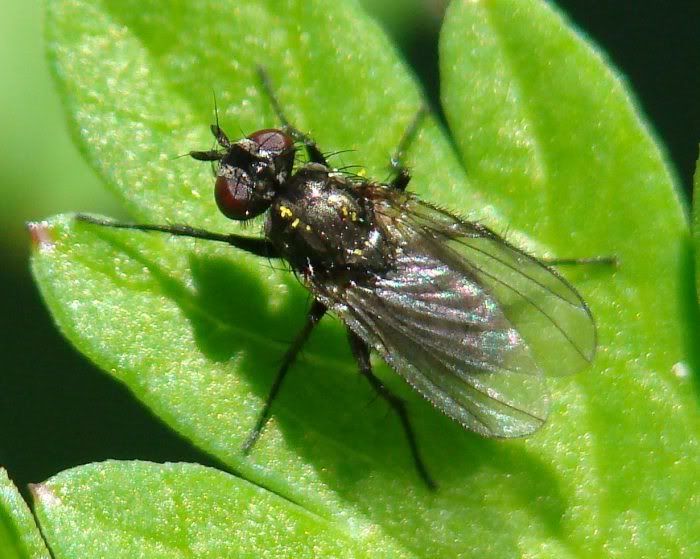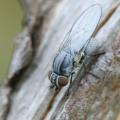Diptera.info :: Identification queries :: Diptera (adults)
Who is here? 1 guest(s)
|
Anthomyiidae > Acyglossa atramentaria (female)
|
|
| valter |
Posted on 06-04-2010 21:53
|
|
Member Location: Faro, Portugal Posts: 1998 Joined: 09.07.07 |
Location: Algarve, Portugal Date: April 2010  Size: smaller than Musca domestica Thanks, Valter Edited by valter on 27-04-2010 08:49 |
| jorgemotalmeida |
Posted on 06-04-2010 22:15
|
|
Member Location: Viseu - PORTUGAL Posts: 9296 Joined: 05.06.06 |
Muscidae. |
| javanerkelens |
Posted on 06-04-2010 22:37
|
|
Member Location: Netherlands Posts: 2962 Joined: 18.10.07 |
Coenosia ? |
|
|
|
| valter |
Posted on 07-04-2010 17:56
|
|
Member Location: Faro, Portugal Posts: 1998 Joined: 09.07.07 |
Fannia manicata  |
| javanerkelens |
Posted on 07-04-2010 20:47
|
|
Member Location: Netherlands Posts: 2962 Joined: 18.10.07 |
I am sorry, but can you convince me why you think it is a Fannia manicata..? The orbital plates+orbitals are indeed Fannia like, but i don't see the typical sc line on the wings..? And i also see an ad seta on the fore tibia and i thought F.manicata has not... Joke 
Edited by javanerkelens on 07-04-2010 20:53 |
|
|
|
| Stephane Lebrun |
Posted on 07-04-2010 21:48
|
|
Member Location: Le Havre, France Posts: 8248 Joined: 03.03.07 |
Not Fannia, and not Coenosia. The wing venation is odd (no M-Cu ?). I think more about a Tachinid (Phytomyptera nigrina has this kind of venation, but I absolutely don't know this species).
Edited by Stephane Lebrun on 07-04-2010 21:49 Stephane. |
|
|
|
| valter |
Posted on 07-04-2010 22:02
|
|
Member Location: Faro, Portugal Posts: 1998 Joined: 09.07.07 |
javanerkelens wrote: I am sorry, but can you convince me why you think it is a Fannia manicata..? The orbital plates+orbitals are indeed Fannia like, but i don't see the typical sc line on the wings..? And i also see an ad seta on the fore tibia and i thought F.manicata has not... Joke  You can see the outcurved orbital seta and two dorsal setae on hind tibia. |
| jorgemotalmeida |
Posted on 07-04-2010 22:17
|
|
Member Location: Viseu - PORTUGAL Posts: 9296 Joined: 05.06.06 |
if tachinid... it would be a very, very unusual one! |
| javanerkelens |
Posted on 07-04-2010 22:31
|
|
Member Location: Netherlands Posts: 2962 Joined: 18.10.07 |
I don't see strong calypters... I get a feeling it even could be an Anthomyiidae. (there are some species with outcurved orbitals....) Joke |
|
|
|
| jorgemotalmeida |
Posted on 07-04-2010 22:40
|
|
Member Location: Viseu - PORTUGAL Posts: 9296 Joined: 05.06.06 |
Collect it! Hope you find it again. |
| Jaakko |
Posted on 08-04-2010 08:04
|
|
Member Location: Joensuu, Finland Posts: 479 Joined: 04.08.08 |
Not a tachinid, at least not a Phytomyptera. How about one of those strange small calliphorids? Angioneura etc? (Not any species we have in the Nordic countries) |
|
|
|
| Stephane Lebrun |
Posted on 08-04-2010 17:26
|
|
Member Location: Le Havre, France Posts: 8248 Joined: 03.03.07 |
Ok, I was on the wrong way : the vein M should be complete and reaching the wing margin, and DM-Cu should be present. Thus it is an Antho, and with the costa stopping at R4+5 level, I propose an Acyglossa sp. (2 species).
Stephane. |
|
|
|
| javanerkelens |
Posted on 08-04-2010 20:25
|
|
Member Location: Netherlands Posts: 2962 Joined: 18.10.07 |
Yes !!! That is the one! Compliments A.pollinosa = interfrontals present + thorax and abdomen greyish dusted A.atramentaria = interfrontals absent + thorax and abdomen shining blackish with sparesely greyish dusting Edited by javanerkelens on 08-04-2010 20:26 |
|
|
|
| Jump to Forum: |













